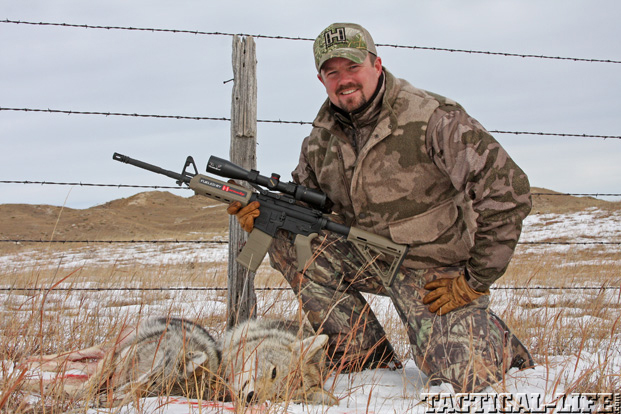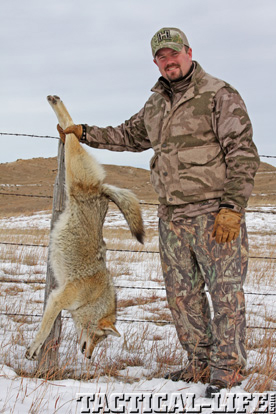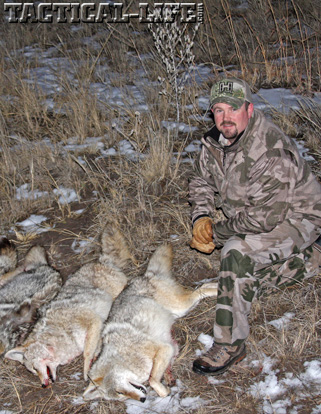Even when Neil Davies is hunting deer and other big game, his thoughts tend to drift toward predator hunting.
“I can’t help it,” said Davies, marketing director of Hornady Manufacturing in Grand Island, Nebraska. “I do a lot of big game hunting, but even when I’m carrying a muzzleloader, I’m thinking about predator hunting. Predators are always a secondary pursuit when I’m out there. It seems I’ve been hunting predators all my life.”
To be more precise, coyotes have fascinated Davies, 38, since he was a 14-year-old novice hunting Nebraska’s fields, woodlots, creek drainages and grass-covered plateaus. “Calling coyotes is fun and it’s challenging,” he said. “Anytime you can interact with an animal by calling, and make them succumb to your whims, it’s a satisfying experience.”
And to make sure his hunts have happy endings, Davies shoots an AR. He likes ARs for many reasons, including familiarity. “I’ve been holding an AR or M-16 variant in my hands since I was 18,” he said. “I was in the Army National Guard from 1993 to 1998, and the Marine Corps from 1998 to 2004. For me and all the other people who have been in the service, the AR is a natural fit. If I added up all the hours I’ve carried an AR in the military and for hunting, I’m sure the total would be more than an entire year. The AR is a great rifle. It sets the standard. In the world of rifles, it’s the equivalent of a Chevy 350 and the Model 1911 pistol.”
Advertisement — Continue Reading Below
Reliable Versatility
Of course, it’s easy to be enamored with ARs. They’ve proven so reliable, versatile and accurate, shot after shot, year after year. “They’re very accurate rifles if they’re built correctly,” Davies said. “The other big thing is their fast follow-up shots for coyote hunting. Whether you miss the first shot or you have doubles coming in, the AR lets you get off follow-up shots with minimal movement. The recoil is light, so your eye doesn’t come off the scope when you’re taking those second, third or more shots when they run for it. That’s probably the AR’s biggest attribute.”
Davies thinks the AR has emerged as a legitimate, widely accepted hunting rifle after years of sometimes-contentious debate among hunters. Some hunters insisted the AR was designed for the battlefield and should remain there. Maybe they never considered that most sporting rifles originated from military designs, or that many hunters during the first half of the 20th century sporterized classic rifles like the .30-40 Krag, 1917 Enfield and ’03-A3 bolt-actions for use in the deer woods.
“When you think about it, the muzzleloader used to be our military’s rifle way back when,” Davies said. “The AR isn’t the first rifle to get its start in the military. But when you pick up an AR like the Smith & Wesson M&P 15 MOE, you see why hunters like them. They’re lightweight, they’re easy to carry, and with that 16-inch barrel, they get on target fast.
Advertisement — Continue Reading Below
“They’re also handy because of their detachable magazines,” he continued. “When you’re hunting coyotes, you’re almost always doing multiple sets. You set up, call, wait and move to your next location. You get in and you get out. AR magazines are easy, fast and simple to load and unload. There’s no fumbling around with loose ammo.”
What Davies likes even more is that each AR can be as unique as the person using it. “The typical AR doesn’t stay in its original stock configuration very long,” he said. “It’s fun to reconfigure them with a new forend and buttstock, different magazines and totally different uppers. You can go with a .223 in a 16-inch carbine, or you can go to a 24-inch bull barrel for a really accurate rig. If that’s not enough versatility, you can change cartridges, and go from a .223 to a 6.8 SPC, a 6.5 Grendel or 450 Bushmaster—and all with same receiver. You only have to go through the firearm buying process one time to get started, and then you can go anywhere you want with it.”
Davies Deadly
Davies’ AR of choice is a gun with a 20-inch (sometimes 24-inch) barrel to achieve maximum velocity out of the cartridges he shoots. He usually shoots a .223/5.56mm or .204 Ruger in the AR-15 platform. Not surprisingly, he recommends Hornady’s Superformance varmint cartridges. For the .223 Remington, he shoots a 53-grain V-Max bullet, which flies at 3,465 FPS.
Advertisement — Continue Reading Below
He also likes the .243 Winchester in the AR-10 platform. “The .243 Winchester is a phenomenal choice,” he said. “With 58-grain V-Max bullets in Superformance ammo, you’ll be at 3,925 feet per second. That’s really smoking. The tradeoff is that an AR-10 is a little bigger, heavier gun than the AR-15. Ultimately, you want a flat-shooting cartridge that delivers ‘minute-of-coyote’ performance out to 300 yards. That’s when a longer barrel comes in handy, so you get a cartridge’s full performance.”
Davies also prefers his hunting rigs to have a camouflaged stock, and chooses colors that match the terrain as closely as possible. “A black stock is okay., but the only black things in nature are shadows,” he said. “If you stay in the shadows, you’ll be all right.” That makes perfect sense.
What about optics for coyote hunting? Davies wants a good variable riflescope that dials down into the 3.5X to 4.5X range for increased field of view. “I’ve been going with the Simmons Predator Quest model,” he said. “When we get a double coming in, I want a wide field of view so I can pick up that second coyote. If you let them come in to 40 yards, your partner can get one with a shotgun, and you need to be able to pick up the other one in your riflescope at 50 yards.
Advertisement — Continue Reading Below
“It just depends on what you’re doing. Some guys would like Simmons’ 6-24x50mm model for long-range shooting, but I’ve been going with the 4.5-18x44mm model. Adjustable turrets are fine, but they’re not necessary for most of the coyote hunting I do. When a coyote comes in, you usually don’t have time to make scope adjustments. After the first shot, it’s usually going to be fast running shots. There aren’t many cases where you’ll have time to turn a turret.”
Coyote Quest
As much as Davies loves ARs, he’s even more passionate about predator hunting, and likes the fact its popularity is spreading. “Predator hunting has become huge,” he said. “There are coyotes all over the country now. They’re showing up in places where they’ve never been before, especially east of the Mississippi River. They’re one of those animals that proliferate alongside humans.”
And when you ask Davies for coyote hunting tips, he downplays his insights and accomplishments. He gives that credit to a fellow Nebraskan, Les Johnson at Predator Quest. “Essentially, everything I know about coyote hunting I learned from Les Johnson,” Davies said. “Les hunts predators for a living, and he’s very good at it.”
Advertisement — Continue Reading Below
Johnson, of course, has earned that praise. In 1999, he became the first and only coyote caller to win all three major championships: the Midwest, National and World Championship. Not only that, but he won them all in the same year. He continues to win coyote calling contests each year, and has also won several awards for his TV show, Predator Quest, which has aired on the Sportsman Channel since 2006.
Killer Setups
Davies has proven to be a worthy predator protégé. As such, when he talks about setting up on coyotes to call them from daytime bedding cover, he starts with the most important factor: wind. “Ideally, you’ll be working with 15 mph winds and less; hopefully, less than 10 mph,” he said. “Mornings are often pretty good because the winds usually aren’t too bad early in the day. Late afternoon and early evenings are also good as the wind starts dying down. Your calls carry farther then. You want to call into the wind when you set up, or position yourself so the wind quarters into you. That way, when they come in, you’ll see them before they try to get around to your backside.”
Once Davies determines wind direction and the setup area, he looks for a spot where he can sit a little higher than where he expects to see the coyotes. To break up his silhouette, he sits in front of a backdrop of brush, stumps, rocks or large plants. If he’s using an electronic caller, he puts it out in front of him to shift the coyotes’ focus away from his location.
Advertisement — Continue Reading Below
He’s also a stickler for total camouflage. “Choose camo clothing that matches the terrain,” Davies said. “Use natural colors, browns and grays, and snow camo in the winter. Never forget to camouflage your hands. Coyotes spot pink hands every time. Make your gloves match the terrain. If it’s cold, keep your head and neck covered with a good hooded sweatshirt. Keep your head down so the sun doesn’t light up your face. Facemasks can help hide your face and keep it warm.”
Davies also suggests carrying a pad to keep moisture off your backside, and wearing waterproof pants. There’s almost always some moisture on the ground.
Deal Closing
When working with another hunter, position the caller behind the primary hunter. “I’ll usually have the guy with the shotgun up front, and the guy in the back will usually have a rifle,” Davies said. “When we hunt Nebraska’s Sandhills, we’ll call into rush beds around lakes and wetlands. We’ll also try to call them from woodlots, farmlands and creek drainages. We see them up on plateaus in wheat fields, too.”
Advertisement — Continue Reading Below
When you spot coyotes approaching, stay still and let them keep coming. “I used to make the mistake of thinking they busted me when they’d stop and stare my way,” Davies said. “Just because they’re staring at you doesn’t mean they’ll bolt. Never move when they’re looking at you. Wait until they start walking or trotting toward the call again. Get ready to shoot when they’re walking to your side. Their peripheral vision isn’t as good as their head-on vision, so watch for them to drop out of sight in dips and depressions. When they do, reach for your gun, get into position, and be ready to shoot.
“Typically, as they close from a couple hundred yards, they’re moving and stalking your calls,” Davies continued. “If they’re moving and they really haven’t sensed danger, and nothing looks out of place, let them keep coming. They’ll come in pretty close, often within shotgun range or just outside of shotgun range. When they look like they need to see what’s going on, you’re safe. But if they gallop to the side and look like they might clear out, make your move.”
Davies usually gives his setups about half an hour before moving to another site. He won’t move, however, until he has looked around carefully to make sure nothing is sneaking in from the side. “Don’t just quit and stand up,” Davies said. “Keep your head moving slowly. Keep scanning to make sure nothing sneaks in on you. Once you’ve checked carefully in all directions, go ahead and move.”
Advertisement — Continue Reading Below
As with any activity, the more times you go coyote hunting, the more mistakes you’ll make, and the more you’ll benefit from the experiences. And the more skilled you become, the more you’ll start understanding why predator hunting is never far from Davies’ thoughts year-round. Before you know it, you’ll be studying potential coyote setups while deer hunting and turkey hunting.
Once you reach that point, you’ll never again view late fall and winter as hunting’s offseason. It’s predator season, and there’s nowhere else you’d rather be. For more, visit hornady.com or call 800-338-3220.


























